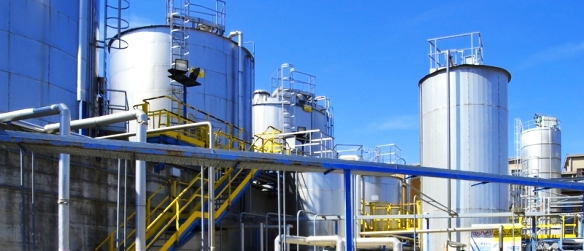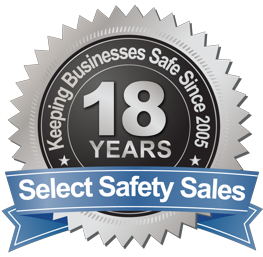| |

Industries That Need Emergency Eyewashes and Showers
Eyewash stations and Emergency Showers are required in many industries where workers are exposed to chemicals and hazardous materials that can damage their eyes. OSHA requires this under their general medical services and first aid standard 1910.151( c) “Where the eyes or body of any person may be exposed to injurious corrosive materials, suitable facilities for quick drenching or flushing of the eyes and body shall be provided within the work area for immediate emergency use”
OSHA delves deeper into this requirement for specific industries:
Battery Charging Facilities
Employees that work in facilities where they can be exposed to electrolyte due to the handling and servicing of batteries should have emergency flushing equipment for the safety of workers in case of an accidental splash. Electrolyte is sometimes referred to as battery acid. This battery acid is actually sulfuric acid which is extremely corrosive. It can cause severe damage to the eyes. According to OSHA 29 CFR 1926.441 (a) (6), there should be facilities for quick drenching of the eyes provided within 25 ft. of the work area in battery charging facilities. OSHA’s compliance directive STD1-8.2 notes that the need for eyewash stations and emergency showers depends on the potential for worker exposure. For example, OSHA is less stringent in the need for eyewash stations in areas for routine battery recharging and overnight storage.
Anhydrous Ammonia Storage Facilities and Vehicles Transporting Ammonia
Anhydrous ammonia is corrosive to the eyes, skin and lungs. For workers in facilities where it is stored, OSHA standard 29CFR 1910.111(b)(10)(iii) addresses the need for an “easily accessible shower”. Anhydrous ammonia is used in a multitude of industries as a refrigerant and also as an agricultural fertilizer. It is stored in liquid form under pressure and becomes toxic when it is released into the environment as a gas. OSHA protects workers that are involved in the transportation of this chemical in 29CFR 1910.111(b)(10)(iv) by requiring five gallons of water be carried in the vehicle transporting the ammonia in bulk.
Industries that use Formaldehyde
Formaldehyde is used in many industries and in the manufacturing process for many products such as building products, automobiles, nail polish, nail hardeners, paper towels and film to name a few. It has been used for many years in many types of facilities and operations. It is used as a preservative in medical labs and an embalming fluid in funeral homes. According to 29CFR 1910.1048 (i)(2) there should be “conveniently located quick drench showers” available for employees that could be splashed with a solution containing formaldehyde (1% or more)
If employees' skin may become splashed with solutions containing 1 percent or greater formaldehyde, for example, because of equipment failure or improper work practices, the employer shall provide conveniently located quick drench showers and assure that affected employees use these facilities immediately.
Industries that Expose Workers to Caustic Soda
Caustic Soda is sodium hydroxide which is a water soluble alkaline chemical. It is highly corrosive and can be extremely irritating to the eyes, skin and gastrointestinal tract. Exposure to the eyes has the potential to cause blindness. Industries that use caustic soda fall under the general standard, and there are also other standards that address the need for flushing equipment in specific industries that use this substance. Caustic Soda has been used for many years in various industrial environments such as:
-
The Pulp and Paper Industry- Caustic Soda is used both in the United States and around the world in the Pulp and Paper industry for various uses. It is used throughout both the bleaching and extraction processes involved in pulping. OSHA standard 29CFR 1910.261(g)(18)(i)) addresses the need of “quick operating showers” in this industry.
- The Textile Industry- Cotton and synthetic fibers such as polyesters and nylons are processed using caustic soda. It removes oils and waxes from the fibers to make them more absorbent for the dye and bleaching process. It also gives the fiber greater strength. OSHA standard 29 CFR 1910.262(pp) calls for a “flowing supply of fresh, clean water” when acids and caustic chemicals are being used during the manufacturing process of textiles.
-
The Detergent and Soap Industry- In the manufacturing of many cleaning products and detergents, caustic soda is an important component and it is also used to convert substances such as vegetable oils and fats into soap.
-
The Petroleum Industry- Odors are removed from chemicals used in the petroleum industry such as sulfides and other chemicals with strong odors. This is accomplished using caustic soda.
-
Bleach Manufacturing – Caustic Soda is used in the manufacturing of bleach which is used in various environments to control mold and mildew buildup.
-
The Aluminum Manufacturing Industry- Caustic Soda is used to dissolve the raw material in aluminum manufacturing.
- Various Types of Chemical Manufacturing Plants- In the chemical industry it is used widely as the primary strong base in many chemical mixtures. Caustic Soda is used in water treatment, drain and oven cleaners, and other cleaning products that are used for both industrial and consumer use.
Industries that Expose Workers to Methylene Chloride
OSHA Standard 29 CFR 1910.1052(i)(2) addresses the need for eyewash facilities in industries that could expose workers to methylene chloride (MC) through splashes or spills with solutions containing .01 % or more of the substance such as when doing paint stripping, working in cleaning and degreasing operations and working in pharmaceutical manufacturing plants.
Facilities for Dipping and Coating
Operations that have large tanks to dip and coat objects such as where furniture is dipped and stripped should have an emergency shower and eyewash station nearby to the tank according to OSHA standard 1910.124 (g). This standard does allows for a water hose in place of the shower or eyewash. It has to have a pressure of 25 lbs per square inch and be at the least four feet long in addition to a valve that opens quickly.
HIV/HBV Research Laboratories and Production Facilities
There are Special Requirements for HIV/HBV Research Laboratories and Production Facilities that engage in the experimentation, production, concentration or culture of HIB and HBV. This is addressed in 29CFR 1910.1030 ( e ) (3). While it does not apply to diagnostic or clinical labs that engage in the analysis of blood, tissues or organs, it is still a good idea to have these safety measures in place in these laboratories.
When accessing the needs and requirements for eyewash stations and emergency showers, it is important to note that there are OSHA general standards in addition to OSHA standards that are specific to certain industries such as construction, OSHA standard Interpretations, OSHA preamble rules and even different statewide rules that must be considered. First and foremost an assessment of the hazards in your particular facility has to be done. This information coupled with OSHA federal and state requirements will make your workplace a safe workplace for your employees.
|
|






